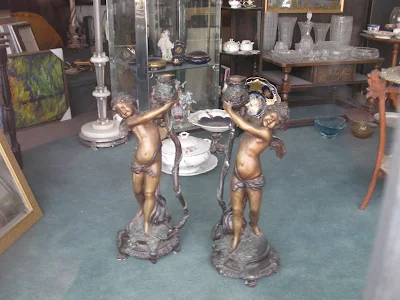





The numinous world is all around us, waiting to break through the unconscious into our awareness. It is like these plastic wolves, found in the window of a dollar store in Alexis Nihon Plaza in Montreal. There the wolves wait, actually quite attractive figurines or statuettes, but still nothing all that special, and yet they are a reminder of the numinous order to things. The numinous--archetypes, metaphor, symbolism, mythology--are always present, always waiting to enter consciousness, always just under the surface of consciousness.
Jungians have always been fascinated by popular culture, which can be an expression of the human psyche and what it contains, represented to us in the everyday--in the quotidian--where it is an expression of our social and cultural concerns, our psychological and spiritual concerns, our collective concerns, unadorned by the aspect of high art that is deliberate and sometimes exclusive.
These wolves remind us, even if it remains unconscious, of the part of the psyche that cannot be tamed, that is always only once removed from primeval and atavistic aspects of consciousness.
I remember, years ago, reading Albert Schweitzer's On the Edge of the Primeval Forest (1922), it was on the reading list for the high schools of the Protestant School Board of Greater Montreal, and then a few years later I read A Heart of Darkness, published twenty years earlier, by Joseph Conrad, both books set in Africa. The first, a benevolent expression of Christianity (the work done at Schweitzer's Lambarene mission) in Africa; the other, how western consciousness is affected by shadow content. Both books are fascinating explorations of European consciousness relocated to a foreign environment. Conrad's vision is more relevant for us as it shows western consciousness when removed from the supports offered by western society, by western mythology. Today, and for the last hundred years years, these supports have been removed for many people in western society. We consider this the decline of western civilization, and the old civilization is indeed in decline and has been for many years, but we also live in a dynamic and vital post-modern world which adapts to change and is capable of re-visioning itself. What most people don't realize is that a new mythology has been created, new psychological supports have been created, that the numinous can never be far removed from consciousness. That we aren't fully aware of these new supports--a new mythology for living--isn't evidence that they don't exist; it is evidence that they are active, vibrant, and relevant. For many people this is a difficult time in which to live, it demands something most people aren't prepared to do, and that is to become people who are conscious and aware.
Note: When I wrote this I could still be a detached observer of things; no longer. The supports of western civilization are being destroyed by people in the west, it is called being woke, but they are not really "woke" or awake, or even aware but they are full of self-hatred. In their rush to destroy the society and culture that educated them and gave them the affluent life that they enjoy, they forget the many achievements of western society. If this is the new mythology of western society, then I didn't see it coming. These woke people want to destroy western society, tear it down, even to the basic unit of society that is the family. (19 February 2023)




.JPG)








.JPG)




























